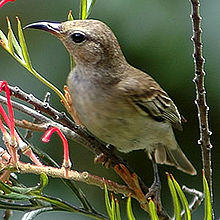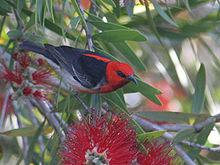- Scarlet Honeyeater
-
Scarlet Honeyeater 
Female Conservation status Scientific classification Kingdom: Animalia Phylum: Chordata Class: Aves Order: Passeriformes Family: Meliphagidae Genus: Myzomela Species: M. sanguinolenta Binomial name Myzomela sanguinolenta
(Latham, 1802)The Scarlet Honeyeater (Myzomela sanguinolenta), also known as Crimson Honeyeater, Scarlet Myzomela, Sanguineous Honeyeater or, colloquially, Bloodbird, is a small passerine bird of the Honeyeater family Meliphagidae native to the east coast of Australia, Indonesia and New Caledonia. The male is a striking bright red with black wings; the female is entirely brown.
Contents
Taxonomy
It was originally described as Certhia sanguinolenta by ornithologist John Latham in 1802.[1] It is a member of the small genus Myzomela with two other red species, the Red-headed Honeyeater of northern Australia and the Cardinal Honeyeater of Vanuatu, as well as the Dusky Honeyeater. It belongs to the honeyeater family Meliphagidae. More recently, DNA analysis has shown honeyeaters to be related to the Pardalotidae, and the Petroicidae (Australian robins) in a large corvid superfamily; some researchers considering all these families in a broadly defined Corvidae.
Description
The male Scarlet Honeyeater is 10–11 cm (4 in) long with a bright red head, breast, back and rump, black tail and wings (wing feathers have white margins) with a white abdomen. The female is a pale brown with a whitish abdomen. Both have black bills and eyes. A variety of calls have been recorded, including a bell-like tinkling.[2]
Males could be mistaken for the similar looking Red-headed Honeyeater in north Queensland where their ranges overlap, though the latter's red colouration is restricted to the head.
Distribution and habitat
The Scarlet Honeyeater is found from Gippsland in Victoria north through eastern coastal Australia east of the Great Dividing Range to Cape York. Outside Australia it occurs in Indonesia, where it is found on Sulawesi, the Maluku and Lesser Sunda Islands, and in New Caledonia.
It is found in forested areas and is omnivorous, feeding on insects as well as nectar.
Breeding
Breeding season is from winter through to summer, with one or two broods a year. The nest consists of a tiny cup of shredded bark with spider web as binding, high up in tree canopy, or even mistletoe.[3] The small eggs are white with the larger end flecked with dull red-brown or grey-purple.[4]
Aviculture
Scarlet Honeyeaters are rarely seen in aviculture. Keeping them successfully requires a large commitment in time and experience. Various State regulations govern the keeping of the species, for instance, in South Australia a Specialist License is required, while in New South Wales a Class 2 licence is required. N.S.W. applicants must have at least 2 years experience keeping birds, and be able to demonstrate that they can provide the appropriate care and housing for the species they wish to obtain.
The late Mr. Neil Tuthill, of Murray Bridge, was awarded an R.W. McKechnie Memorial Medal by The Avicultural Society of South Australia Inc., for the first breeding of the Scarlet Honey-eater in South Australia.
References
- ^ Latham, J. (1802). Supplementum Indicis Ornithologici, sive Systematis Ornithologiae. London: G. Leigh, J. & S. Sotheby 74 pp. [37]
- ^ Simpson K, Day N, Trusler P (1993). Field Guide to the Birds of Australia. Ringwood, Victoria: Viking O'Neil. p. 392. ISBN 0-670-90478-3.
- ^ Cooney SJN, Watson DM, Young J (2006). "Mistletoe nesting in Australian birds: a review". Emu (CSIRO Publishing) 106: 1–12. doi:10.1071/MU04018. https://www.anu.edu.au/BoZo/stuart/Papers/MU040181.pdf. Retrieved 2007-06-07.
- ^ Beruldsen, G (2003). Australian Birds: Their Nests and Eggs. Kenmore Hills, Qld: self. p. 329. ISBN 0-646-42798-9.
- ^ NSW NPWS (2003). "NSW Bird Keepers’ Licence Species Lists". NSW NPWS. http://www.nationalparks.nsw.gov.au/PDFs/bird_licensing_outline.pdf. Retrieved 2007-06-06.
- BirdLife International (2004). Myzomela sanguinolenta. 2006. IUCN Red List of Threatened Species. IUCN 2006. www.iucnredlist.org. Retrieved on 12 May 2006. Database entry includes justification for why this species is of least concern
Categories:- IUCN Red List least concern species
- Birds of Australia
- Myzomela
- Animals described in 1802
Wikimedia Foundation. 2010.


